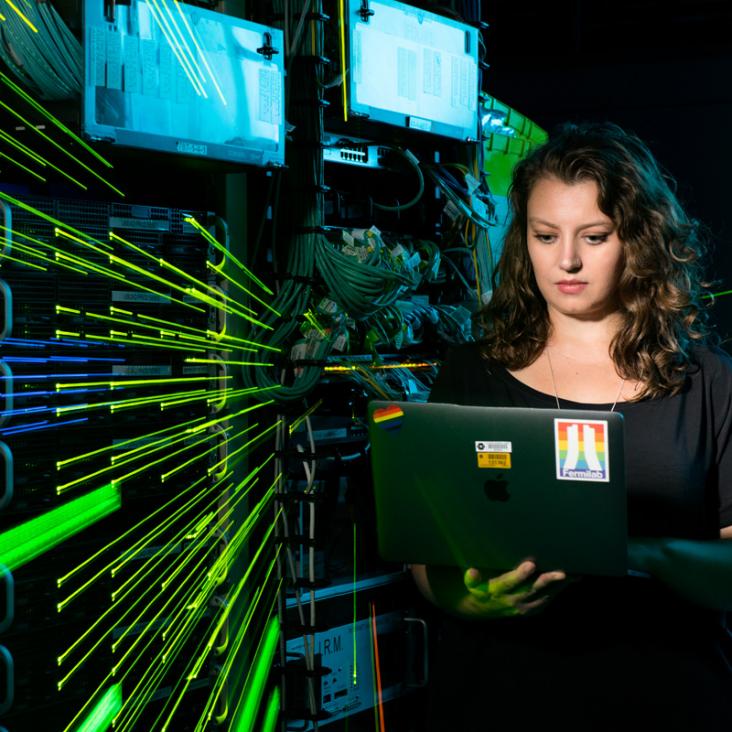Deep Underground Neutrino Experiment (DUNE) near detector conceptual design report
Instruments MDPI 5:4 (2021) 31
Abstract:
The Deep Underground Neutrino Experiment (DUNE) is an international, world-class experiment aimed at exploring fundamental questions about the universe that are at the forefront of astrophysics and particle physics research. DUNE will study questions pertaining to the preponderance of matter over antimatter in the early universe, the dynamics of supernovae, the subtleties of neutrino interaction physics, and a number of beyond the Standard Model topics accessible in a powerful neutrino beam. A critical component of the DUNE physics program involves the study of changes in a powerful beam of neutrinos, i.e., neutrino oscillations, as the neutrinos propagate a long distance. The experiment consists of a near detector, sited close to the source of the beam, and a far detector, sited along the beam at a large distance. This document, the DUNE Near Detector Conceptual Design Report (CDR), describes the design of the DUNE near detector and the science program that drives the design and technology choices. The goals and requirements underlying the design, along with projected performance are given. It serves as a starting point for a more detailed design that will be described in future documents.Measurement of the longitudinal diffusion of ionization electrons in the MicroBooNE detector
Journal of Instrumentation IOP Science 16:9 (2021) P09025
Abstract:
Accurate knowledge of electron transport properties is vital to understanding the information provided by liquid argon time projection chambers (LArTPCs). Ionization electron drift-lifetime, local electric field distortions caused by positive ion accumulation, and electron diffusion can all significantly impact the measured signal waveforms. This paper presents a measurement of the effective longitudinal electron diffusion coefficient, DL, in MicroBooNE at the nominal electric field strength of 273.9 V/cm. Historically, this measurement has been made in LArTPC prototype detectors. This represents the first measurement in a large-scale (85 tonne active volume) LArTPC operating in a neutrino beam. This is the largest dataset ever used for this measurement. Using a sample of ∼70,000 through-going cosmic ray muon tracks tagged with MicroBooNE's cosmic ray tagger system, we measure DL = 3.74+0.28-0.29 cm2/s.Measurement of the flux-averaged inclusive charged-current electron neutrino and antineutrino cross section on argon using the NuMI beam and the MicroBooNE detector
Physical Review D American Physical Society 104:5 (2021) 52002
Abstract:
We present a measurement of the combined νe+ν¯e flux-averaged charged-current inclusive cross section on argon using data from the MicroBooNE liquid argon time projection chamber (lartpc) at Fermilab. Using the off-axis flux from the NuMI beam, MicroBooNE has reconstructed 214 candidate νe+ν¯e interactions with an estimated exposure of 2.4×1020 protons on target. Given the estimated purity of 38.6%, this implies the observation of 80 νe+ν¯e events in argon, the largest such sample to date. The analysis includes the first demonstration of a fully automated application of a dE/dx-based particle discrimination technique of electron- and photon-induced showers in a lartpc neutrino detector. The main background for this first νe analysis is cosmic ray contamination. Significantly higher purity is expected in underground detectors, as well as with next-generation reconstruction algorithms. We measure the νe+ν¯e flux-averaged charged-current total cross section to be 6.84±1.51(stat)±2.33(sys)×10-39 cm2/nucleon, for neutrino energies above 250 MeV and an average neutrino flux energy of 905 MeV when this threshold is applied. The measurement is sensitive to neutrino events where the final state electron momentum is above 48 MeV/c, includes the entire angular phase space of the electron, and is in agreement with the theoretical predictions from genie and nuwro. This measurement is also the first demonstration of electron-neutrino reconstruction in a surface lartpc in the presence of cosmic-ray backgrounds, which will be a crucial task for surface experiments like those that comprise the short-baseline neutrino program at Fermilab.Cosmic ray background rejection with wire-cell LArTPC event reconstruction in the MicroBooNE detector
Physical Review Applied American Physical Society 15:6 (2021) 64071
Abstract:
For a large liquid-argon time-projection chamber (LArTPC) operating on or near the Earth's surface to detect neutrino interactions, the rejection of cosmogenic background is a critical and challenging task because of the large cosmic-ray flux and the long drift time of the time-projection chamber. We introduce a superior cosmic background rejection procedure based on the Wire-Cell three-dimensional (3D) event reconstruction for LArTPCs. From an initial 1:20 000 neutrino to cosmic-ray background ratio, we demonstrate these tools on data from the MicroBooNE experiment and create a high-performance generic neutrino event selection with a cosmic contamination of 14.9% (9.7%) for a visible energy region greater than O(200) MeV. The neutrino interaction selection efficiency is 80.4% and 87.6% for inclusive νμ charged-current and νe charged-current interactions, respectively. This significantly improved performance compared with existing reconstruction algorithms marks a major milestone toward reaching the scientific goals of LArTPC neutrino oscillation experiments operating near the Earth's surface.Neutrino event selection in the MicroBooNE liquid argon time projection chamber using Wire-Cell 3D imaging, clustering, and charge-light matching
Journal of Instrumentation IOP Publishing 16:06 (2021) p06043


